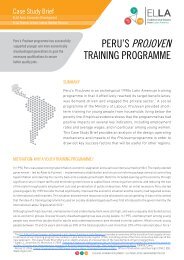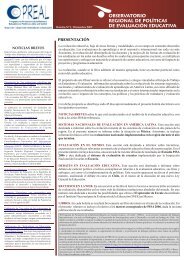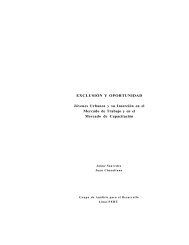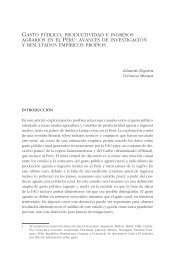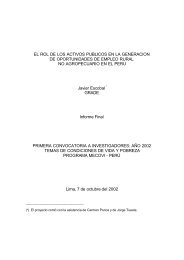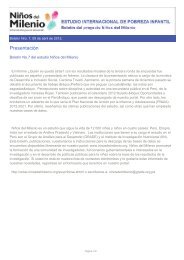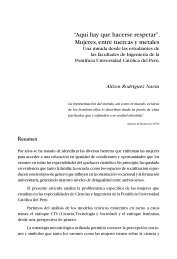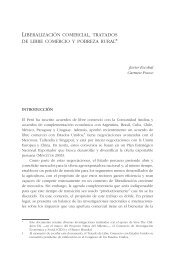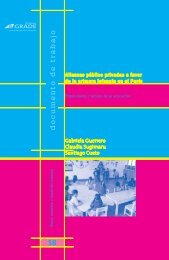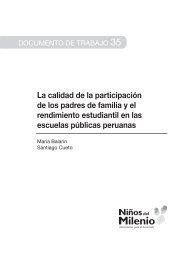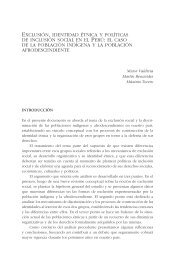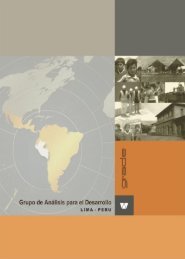Presentación de Javier Escobal - Grade
Presentación de Javier Escobal - Grade
Presentación de Javier Escobal - Grade
You also want an ePaper? Increase the reach of your titles
YUMPU automatically turns print PDFs into web optimized ePapers that Google loves.
Desigualdad espacial en el Perú en las<br />
últimas tres décadas<br />
<strong>Javier</strong> <strong>Escobal</strong><br />
Carmen Ponce
Esquema <strong>de</strong> la <strong>Presentación</strong><br />
o Percepciones sobre la evolución <strong>de</strong> la Desigualdad<br />
o Necesidad <strong>de</strong> construir indicadores <strong>de</strong> Pobreza y<br />
Desigualdad consistentes para antes <strong>de</strong>l 2004.<br />
• Aplicación <strong>de</strong> la metodología sugerida por Elbers, Lanjouw y<br />
Lanjouw (2004)<br />
o Estimación <strong>de</strong>l gasto per-cápita, pobreza y medidas <strong>de</strong><br />
<strong>de</strong>sigualdad a mayores niveles <strong>de</strong> <strong>de</strong>sagregación<br />
geográfica<br />
o El problema <strong>de</strong> la cola <strong>de</strong> la distribución: corrección <strong>de</strong> las<br />
medidas <strong>de</strong> <strong>de</strong>sigualdad por sub-reporte <strong>de</strong>l segmento más<br />
rico<br />
o<br />
o<br />
Polarización espacial<br />
Explicación preliminar sobre las ten<strong>de</strong>ncias i<strong>de</strong>ntificadas:<br />
o Elasticida<strong>de</strong>s crecimiento pobreza
Percepciones<br />
o<br />
o<br />
“Mientras que la <strong>de</strong>sigualdad obtenida a partir <strong>de</strong> las<br />
encuestas se reduce, la obtenida a partir <strong>de</strong> las cuentas<br />
nacionales se incrementa”. (Otra Mirada: Informe N°255,<br />
09/06/2010)<br />
“...si tomamos en cuenta el crecimiento exponencial <strong>de</strong><br />
las utilida<strong>de</strong>s mineras en los últimos años, resulta válida<br />
la hipótesis que la <strong>de</strong>sigualdad en el ingreso se haya<br />
incrementado”. (Otra Mirada: Informe N°294,<br />
12/08/2010)
Problemas <strong>de</strong> comparabilidad intertemporal<br />
Figueroa 50s, 60s CEPAL 1995‐2005 diferencia<br />
Argentina 0.43 0.48 0.05<br />
Brazil 0.58 0.56 ‐0.02<br />
Chile 0.50 0.55 0.05<br />
Colombia 0.58 0.55 ‐0.03<br />
Costa Rica 0.37 0.47 0.10<br />
Mexico 0.54 0.51 ‐0.03<br />
Peru 0.62 0.50 ‐0.12<br />
EEUU 0.36 0.40 0.04<br />
Fuentes: Figueroa, A. y R. Weisskoff (1974): “Visión <strong>de</strong> las<br />
Pirámi<strong>de</strong>s Sociales: Distribución <strong>de</strong>l ingreso en America Latina”.<br />
PUCP Documentos <strong>de</strong> Trabajo. No. 15.<br />
PNUD (2010): Informe Regional sobre Desarrollo Humano para<br />
América Latina y el Caribe 2010: Actuar sobre el futuro: romper la<br />
transmisión intergeneracional <strong>de</strong> la <strong>de</strong>sigualdad
Necesidad <strong>de</strong> construir indicadores <strong>de</strong> Pobreza<br />
y Desigualdad consistentes para antes <strong>de</strong>l 2004<br />
o<br />
o<br />
o<br />
o<br />
A partir <strong>de</strong>l 2004 (datos anuales) o 2002-IV trimestre, la<br />
información <strong>de</strong> las encuestas <strong>de</strong> hogares son consistentes. Para<br />
antes <strong>de</strong> esa fecha la data no es comparable.<br />
Las encuestas <strong>de</strong> hogares no son compatibles con cuentas<br />
nacionales (subestiman el gasto <strong>de</strong> consumo). Esto estaría<br />
asociado a sub-reporte <strong>de</strong> los más ricos.<br />
Los niveles <strong>de</strong> inferencia <strong>de</strong> los datos <strong>de</strong> pobreza y <strong>de</strong> la<br />
distribución <strong>de</strong>l ingreso no son suficientemente <strong>de</strong>tallados como<br />
para darnos una i<strong>de</strong>a <strong>de</strong> la distribución a niveles <strong>de</strong><br />
<strong>de</strong>sagregación espacial mayor (i.e. Provincias)<br />
Es posible enfrentar el problema combinando la información <strong>de</strong><br />
encuestas, la información <strong>de</strong>l censo <strong>de</strong> población y otra<br />
información complementaria (censo agrario, Censo continuo,<br />
registros administrativos. Información geográfica, etc.
Combinando encuestas <strong>de</strong> hogares y Censos<br />
o Metodología <strong>de</strong>sarrollada por Elbers, Lanjouw y Lanjouw (2004)<br />
o La relación funcional a estimar en la primera etapa tiene la siguiente<br />
forma:<br />
o<br />
G = x ' β +<br />
ch<br />
ch<br />
G ch<br />
es el logaritmo <strong>de</strong>l gasto per cápita <strong>de</strong>l hogar h, resi<strong>de</strong>nte <strong>de</strong>l distrito<br />
c, X ch<br />
es el vector <strong>de</strong> características <strong>de</strong>l hogar h (incluye características<br />
individuales y distritales <strong>de</strong>l hogar h), y β es el vector <strong>de</strong> parámetros a<br />
estimar.<br />
u<br />
ch<br />
o<br />
o<br />
Un elemento central en esta metodología es la mo<strong>de</strong>lación <strong>de</strong>l error. El<br />
vector u h<br />
(que se asume satisface el supuesto E[ u y se distribuye<br />
h| x<br />
h]=0<br />
como u ≈ f (0, ) ) tiene la siguiente forma:<br />
∑<br />
u<br />
ch<br />
=η + ε<br />
c<br />
ch<br />
Don<strong>de</strong> η c<br />
es el componente “espacial” <strong>de</strong>l error, común a los hogares que<br />
resi<strong>de</strong>n en el distrito c, y ε ch<br />
es el componente idiosincrásico <strong>de</strong>l error.
Ajuste <strong>de</strong> requerimientos calóricos y<br />
coeficiente <strong>de</strong> Engel<br />
Se requiere<br />
compatibilizar,<br />
gastos, líneas <strong>de</strong><br />
pobreza, etc.<br />
Requerimientos calóricos per cápita utilizados en el cálculo <strong>de</strong> la línea<br />
Dominio<br />
Requerimientos calóricos oficiales Requerimientos calóricos ajustados *<br />
1985 1994 2006 1985 1994 2006<br />
Costa Urbana (sin LM) 2,371 2,371 2,194 2,161 2,167 2,214<br />
Costa Rural 2,371 2,371 2,194 2,133 2,131 2,218<br />
Sierra Urbana 2,648 2,648 2,194 2,140 2,181 2,226<br />
Sierra Rural 2,648 2,648 2,133 2,071 2,120 2,148<br />
Selva Urbana 2,385 2,385 2,194 2,129 2,131 2,202<br />
Selva Rural 2,385 2,385 2,133 2,091 2,088 2,162<br />
Lima Metropolitana (LM) 2,371 2,371 2,232 2,185 2,220 2,229<br />
Fuente: ENNIV 1985, ENNIV 1994, ENAHO 2006<br />
Coeficientes <strong>de</strong> Engel utilizados en el cálculo <strong>de</strong> la línea<br />
Dominio<br />
Coeficiente <strong>de</strong> Engel oficiales Coeficiente <strong>de</strong> Engel ajustados *<br />
1985 1994 2006 1985 1994 2006<br />
Costa Urbana (sin LM) 56% 49% 51% 44% 44% 43%<br />
Costa Rural 69% 54% 58% 54% 54% 55%<br />
Sierra Urbana 58% 47% 52% 49% 42% 43%<br />
Sierra Rural 78% 64% 64% 69% 67% 66%<br />
Selva Urbana 50% 52% 60% 51% 50% 47%<br />
Selva Rural 56% 60% 63% 65% 61% 63%<br />
Lima Metropolitana (LM) 57% 50% 45% 42% 42% 41%<br />
Urbano 44% 43% 42%<br />
Rural 65% 63% 64%<br />
Nacional 49% 47% 48%<br />
Fuente: ENNIV 1985, ENNIV 1994, ENAHO 2006
Validación Interna: 1994<br />
TASA DE POBREZA<br />
ENNIV 1985 Estimación Censo 1981<br />
Dominio<br />
Tasa <strong>de</strong> Intervalo <strong>de</strong> Confianza Tasa <strong>de</strong> Error<br />
Geográfico<br />
Pobreza<br />
(95%)<br />
Pobreza Estándar<br />
Costa Urbana 47% 40% 53% 50% 0.01<br />
Costa Rural 52% 43% 62% 47% 0.01<br />
Sierra Urbana 31% 22% 40% 33% 0.03<br />
Sierra Rural 42% 37% 47% 40% 0.02<br />
Selva Urbana 32% 13% 51% 26% 0.02<br />
Selva Rural 58% 47% 69% 54% 0.03<br />
Lima Metropolitana 28% 23% 32% 32% 0.01<br />
Urbano 34% 30% 37% 37% 0.01<br />
Rural 47% 42% 52% 43% 0.02<br />
Nacional 39% 36% 42% 40% 0.01<br />
Líneas <strong>de</strong> pobreza total calculada sobre poblaciones <strong>de</strong> referencia para cada dominio y engels por dominio.<br />
Nota general a los tres cuadros: El Censo 1981 no incluye información <strong>de</strong> Loreto, San Martín y Apurímac,<br />
lo que afecta el nivel <strong>de</strong> precisión <strong>de</strong> los indicadores <strong>de</strong> Selva Urbana fundamentalmente.
Validación Interna: 1994 y 2006<br />
TASA DE POBREZA<br />
ENNIV 1994 Estimación Censo 1993<br />
Dominio<br />
Tasa <strong>de</strong> Intervalo <strong>de</strong> Confianza Tasa <strong>de</strong> Error<br />
Geográfico<br />
Pobreza<br />
(95%)<br />
Pobreza Estándar<br />
Costa Urbana 57% 50% 64% 59% 0.01<br />
Costa Rural 65% 54% 76% 62% 0.01<br />
Sierra Urbana 45% 37% 53% 49% 0.01<br />
Sierra Rural 56% 50% 62% 57% 0.01<br />
Selva Urbana 43% 36% 51% 42% 0.02<br />
Selva Rural 67% 61% 73% 67% 0.01<br />
Lima Metropolitana 49% 44% 54% 48% 0.03<br />
Urbano 50% 47% 53% 51% 0.01<br />
Rural 59% 55% 63% 60% 0.01<br />
Nacional 53% 51% 56% 54% 0.01<br />
Líneas <strong>de</strong> pobreza total calculada sobre poblaciones <strong>de</strong> referencia para cada dominio y engels por dominio.<br />
TASA DE POBREZA<br />
ENAHO 2006 Estimación Censo 2005<br />
Dominio<br />
Tasa <strong>de</strong> Intervalo <strong>de</strong> Confianza Tasa <strong>de</strong> Error<br />
Geográfico<br />
Pobreza<br />
(95%)<br />
Pobreza Estándar<br />
Costa Urbana 44% 41% 47% 43% 0.02<br />
Costa Rural 56% 50% 61% 55% 0.01<br />
Sierra Urbana 56% 53% 59% 55% 0.01<br />
Sierra Rural 76% 73% 78% 76% 0.01<br />
Selva Urbana 66% 61% 71% 65% 0.02<br />
Selva Rural 64% 61% 68% 63% 0.02<br />
Lima Metropolitana 33% 30% 35% 31% 0.02<br />
Urbano 43% 42% 45% 42% 0.01<br />
Rural 70% 68% 72% 70% 0.01<br />
Nacional 53% 51% 54% 51% 0.01<br />
Líneas <strong>de</strong> pobreza total calculada sobre poblaciones <strong>de</strong> referencia para cada dominio y engels por dominio.
Estimaciones Alternativas <strong>de</strong> Pobreza<br />
Dominio<br />
Oficial * Ajustada **<br />
1985 1994 2006 1985 1994 2006<br />
Costa Urbana (sin LM) 42% 46% 30% 47% 57% 44%<br />
Costa Rural 50% 55% 49% 52% 65% 56%<br />
Sierra Urbana 35% 41% 40% 31% 45% 56%<br />
Sierra Rural 49% 59% 76% 42% 56% 76%<br />
Selva Urbana 48% 36% 50% 32% 43% 66%<br />
Selva Rural 69% 60% 62% 58% 67% 64%<br />
Lima Metropolitana (LM) 26% 38% 24% 28% 49% 33%<br />
Urbano 33% 40% 31% 34% 50% 43%<br />
Rural 54% 59% 69% 47% 59% 70%<br />
Nacional 41% 47% 44% 39% 53% 53%<br />
Fuente: ENNIV 1985, ENNIV 1994, ENAHO 2006<br />
Tasa <strong>de</strong> Pobreza<br />
Las cifras “oficiales” tienen problemas <strong>de</strong><br />
comparabilidad y pue<strong>de</strong>n mostrar ten<strong>de</strong>ncias erróneas
Crecimiento Provincial 1993 - 2005<br />
Crecimiento <strong>de</strong>l gpc 93-05<br />
CRECIM9305<br />
-0.407762 - -0.154864<br />
-0.154863 - 0.010994<br />
0.010995 - 0.233164<br />
0.233165 - 0.498624<br />
0.498625 - 0.948419
Cambios en la Pobreza Provincial 1993 - 2005<br />
cambio en tasa <strong>de</strong> pobreza 93-05<br />
-0.319444 - -0.104479<br />
-0.104478 - 0.021221<br />
0.021222 - 0.108782<br />
0.108783 - 0.190185<br />
0.190186 - 0.316572
Dinámicas <strong>de</strong> Pobreza 1981 – 1993 - 2005<br />
1981 1993 2005<br />
provincia 2005<br />
0.167795 - 0.300000<br />
0.300001 - 0.450000<br />
0.450001 - 0.600000<br />
0.600001 - 0.750000<br />
0.750001 - 0.900000
Concentración espacial <strong>de</strong> dinámicas<br />
1993 2005
Evolución <strong>de</strong> la Desigualdad<br />
○ Luego <strong>de</strong> compatibilizar los gastos entre encuestas y ajustar<br />
el gasto usando <strong>de</strong>flactores espaciales:<br />
Evolución <strong>de</strong> la Desigualdad (Gini)<br />
1985 1994 2006<br />
Urbano 0.42 0.37 0.36<br />
Rural 0.40 0.37 0.30<br />
Peru 0.45 0.41 0.40<br />
Desigualdad en el acceso a la educación *<br />
(Años <strong>de</strong> educación <strong>de</strong>l Jefe <strong>de</strong>l hogar)<br />
1981 1993 2007<br />
Theil 0.249 0.216 0.146<br />
Gini 0.365 0.350 0.256<br />
Descomposición (importancia <strong>de</strong>l componente entre grupos)<br />
Grupos 1981 1993 2007<br />
rural/urbano 29.76% 16.69% 33.52%<br />
jerarquía urbana 10.06% 8.31% 14.88%<br />
* Se excluye a Apurímac, Loreto y San Martín.
ENAHO versus Cuentas Nacionales<br />
○ Incompatibilidad <strong>de</strong> las Encuestas <strong>de</strong> Hogares con Cuentas<br />
Nacionales<br />
▪<br />
▪<br />
▪<br />
▪<br />
“Las Encuestas <strong>de</strong> Hogares no registran los ingresos (gastos) <strong>de</strong> los más<br />
ricos<br />
Esto se refleja en el hecho que el gasto <strong>de</strong> consumo registrado en<br />
Cuentas Nacionales es muy superior al gasto per cápita <strong>de</strong> ENAHO<br />
(aprox. 70% más alto!)<br />
Yamada y Castro (2006) muestran que cuando se ajusta el gini por<br />
cuentas nacionales - usando la corrección sugerida por Lopez y Serven<br />
(2006) el indicador se incrementa sustantivamente (<strong>de</strong> 0.376 a 0.566 en<br />
el 2004)<br />
Si uno ajusta los Gini que hemos calculado, los indicadores,<br />
como era <strong>de</strong> esperar, aumentan PERO la ten<strong>de</strong>ncia es muy<br />
parecida
Evolución <strong>de</strong> la Desigualdad ... incluyendo<br />
corrección cuentas nacionales<br />
○ Si se presume que la distribución <strong>de</strong>l ingreso (gasto per cápita)<br />
es log-normal<br />
Gini ‐ Corrección por Cuentas Nacionales<br />
1985 1994 2004 2006 2009<br />
Gini ‐ Original 0.45 0.41 0.37 0.39 0.36<br />
Gini ‐ Corregido 0.52 0.52 0.55 0.54 0.50<br />
○ Los resultados parecen ser similares si se reemplaza el supuesto<br />
<strong>de</strong> log-normalidad y se ajusta la distribución a una <strong>de</strong>l tipo<br />
Singh-Maddala o Dagum (u otra que tenga colas más anchas)<br />
○ A nivel agregado no habría evi<strong>de</strong>ncia <strong>de</strong> incremento <strong>de</strong>l gini.<br />
○ Sin embargo, esto no significa que la <strong>de</strong>sigualdad no se esté<br />
incrementando en alguna dimensión relevante (urbano/rural,<br />
más educado / menos educado, etc.)
Cambios en <strong>de</strong>sigualdad 1993-2005<br />
Descomposición <strong>de</strong> la Desigualdad <strong>de</strong>l Gasto per‐cápita<br />
(a partir <strong>de</strong>l Theil <strong>de</strong>l Gasto Per‐capita real a precios <strong>de</strong> Lima)<br />
Entre Categorias Entre Categorias<br />
Grupos<br />
1993<br />
2005<br />
rural/urbano 1.3% 10.4%<br />
nivel educativo 13.2% 26.2%<br />
rural/urbano+ Educ 13.4% 27.9%<br />
provincias 4.9% 20.7%<br />
rural/urbano+provincias 7.0% 22.3%<br />
electricidad 5.0% 12.3%<br />
rural/urbano+ Electricidad 5.3% 14.7%<br />
jerarquía urbana 1.5% 13.1%<br />
Theil 0.232 0.223<br />
No pasa<br />
mucho<br />
en el<br />
agregado<br />
pero las<br />
diferenci<br />
as entre<br />
grupos<br />
se<br />
amplían!
Cambios en <strong>de</strong>sigualdad 1981-1993-2005<br />
Descomposición <strong>de</strong> la Desigualdad <strong>de</strong>l Gasto per‐cápita<br />
(a partir <strong>de</strong>l Theil <strong>de</strong>l Gasto Per‐capita real a precios <strong>de</strong> Lima)<br />
Entre Categorias Entre Categorias Entre Categorias<br />
Grupos<br />
1981<br />
1993<br />
2005<br />
rural/urbano 0.4% 1.1% 10.7%<br />
nivel educativo 10.5% 13.4% 26.3%<br />
rural/urbano+ Educ 11.3% 13.7% 28.2%<br />
provincias 7.3% 5.5% 20.2%<br />
rural/urbano+provincias 9.8% 7.1% 21.7%<br />
electricidad 3.7% 5.1% 12.1%<br />
rural/urbano+ Electricidad 4.7% 5.6% 14.6%<br />
jerarquía urbana 0.7% 1.4% 13.6%<br />
Theil 0.306 0.233 0.223<br />
* Se excluye a Apurímac, Loreto y San Martín.
Reducción <strong>de</strong> la <strong>de</strong>sigualdad al interior <strong>de</strong> las distintas<br />
jerarquías urbano-rurales (en un contexto <strong>de</strong> creciente<br />
polarización espacial<br />
Theil <strong>de</strong>l Gasto Per‐capita real a precios <strong>de</strong> Lima<br />
Grupos<br />
Intra‐categorías<br />
1993<br />
Intra‐categorías<br />
2005<br />
Gran<strong>de</strong>s ciuda<strong>de</strong>s 0.22 0.22<br />
Ciuda<strong>de</strong>s Intermedias 0.24 0.18<br />
Rurales 0.24 0.17<br />
Theil <strong>de</strong>l Gasto Per‐capita real a precios <strong>de</strong> Lima<br />
Grupos<br />
Intra‐categorías<br />
1981<br />
Intra‐categorías<br />
1993<br />
Intra‐categorías<br />
2005<br />
Gran<strong>de</strong>s ciuda<strong>de</strong>s 0.28 0.22 0.21<br />
Ciuda<strong>de</strong>s Intermedias 0.33 0.24 0.17<br />
Rurales 0.33 0.23 0.17<br />
* Se excluye a Apurímac, Loreto y San Martín.
Distribución espacial <strong>de</strong>l Bienestar<br />
Evolución <strong>de</strong>l Gasto Per capita a precios <strong>de</strong> Lima (welfare ratio)<br />
Grupos 1981 1993 2005<br />
Gran<strong>de</strong>s ciuda<strong>de</strong>s 2.075 1.550 1.840<br />
Ciuda<strong>de</strong>s Intermedias 1.834 1.419 1.269<br />
Rurales 1.931 1.348 1.046<br />
Nacional 1.972 1.460 1.495<br />
* Se excluye a Apurímac, Loreto y San Martín.<br />
Cambios en la Distribución espacial <strong>de</strong>l Gasto Per capita (a precios <strong>de</strong> Lima)<br />
Grupos 1981 1993 2005<br />
Gran<strong>de</strong>s ciuda<strong>de</strong>s 43% 48% 50%<br />
Ciuda<strong>de</strong>s Intermedias 21% 23% 24%<br />
Rurales 36% 30% 27%<br />
Nacional 100% 100% 100%<br />
* Se excluye a Apurímac, Loreto y San Martín.
Dinámica <strong>de</strong> la Pobreza por tipo <strong>de</strong> provincia<br />
1981, 1993 y 2005<br />
Nota: No incluye a los <strong>de</strong>partamentos <strong>de</strong> Apurímac, Loreto y San Martín. En el Anexo 8.1 se muestran los resultados <strong>de</strong> 1993 y 2005 que incluyen a estos <strong>de</strong>partamentos. No hay diferencias<br />
importantes en estos indicadores entre ambas tablas.<br />
Fuente: Estimaciones propias en base a los censos <strong>de</strong> Población 1981, 1993 y 2005, las ENNIV 1985, 1994 y la ENAHO 2006.
Cambios en la distribución <strong>de</strong>l gasto a nivel<br />
Provincial<br />
(a) Nacional<br />
(b) Distribución Provincial<br />
0 .2 .4 .6 .8<br />
Distribución <strong>de</strong>l Gasto Per Cápita entre 1993 y 2005<br />
-1 0 1 2 3<br />
(welfare ratio <strong>de</strong>flacftado por líneas <strong>de</strong> <strong>de</strong> pobreza - escala logarítmica)<br />
1993 2005<br />
Cambios en la distribución <strong>de</strong>l gasto per cápita entre 1993 y 2005<br />
0<br />
k<strong>de</strong>nsity<br />
1<br />
lwrlpt93<br />
2 3<br />
-.5 0 .5 1<br />
Welfare ratio <strong>de</strong>flactado por línea <strong>de</strong> pobreza<br />
k<strong>de</strong>nsity lwrlpt93<br />
k<strong>de</strong>nsity lwrlpt05<br />
.2 .4 .6 .8 1 1.2<br />
k<strong>de</strong>nsity lwrlpt05<br />
(c) Provincias con Ciuda<strong>de</strong>s Intermedias<br />
(d) Provincias Rurales<br />
Cambios en la distribución <strong>de</strong>l gasto per cápita entre 1993 y 2005<br />
.5 1<br />
k<strong>de</strong>nsity<br />
1.5<br />
lwrlpt93<br />
2 2.5<br />
0 .5 1 1.5 2 2.5<br />
k<strong>de</strong>nsity lwrlpt05<br />
Cambios en la distribución <strong>de</strong>l gasto per cápita entre 1993 y 2005<br />
0<br />
k<strong>de</strong>nsity<br />
1<br />
lwrlpt93<br />
2 3<br />
0 .5 1 1.5 2<br />
k<strong>de</strong>nsity lwrlpt05<br />
-.4 -.2 0 .2 .4 .6<br />
Welfare ratio <strong>de</strong>flactado por línea <strong>de</strong> pobreza<br />
k<strong>de</strong>nsity lwrlpt93<br />
k<strong>de</strong>nsity lwrlpt05<br />
-.5 0 .5 1<br />
Welfare ratio <strong>de</strong>flactado por línea <strong>de</strong> pobreza<br />
k<strong>de</strong>nsity lwrlpt93<br />
k<strong>de</strong>nsity lwrlpt05
Explicación preliminar sobre las ten<strong>de</strong>ncias<br />
i<strong>de</strong>ntificadas: El reto <strong>de</strong> la <strong>de</strong>sigualdad y el Perú rural<br />
o<br />
o<br />
Desigualdad sigue alta y aunque en el agregado muestre cierta<br />
ten<strong>de</strong>ncia <strong>de</strong>creciente hay ciertas dimensiones <strong>de</strong> <strong>de</strong>sigualdad (en<br />
particular la <strong>de</strong>sigualdad espacial) que está creciendo<br />
Esta <strong>de</strong>sigualdad se origina<br />
• Desigualdad <strong>de</strong> accesos a servicios (más allá <strong>de</strong> los básicos..)<br />
• Desigualdad en el acceso a factores <strong>de</strong> producción<br />
• Desigualdad en la posibilidad <strong>de</strong> ejercer <strong>de</strong>rechos ciudadanos<br />
→ Desigualdad <strong>de</strong> Oportunida<strong>de</strong>s
Explicación preliminar sobre las ten<strong>de</strong>ncias<br />
i<strong>de</strong>ntificadas
Concentración espacial <strong>de</strong> la Pobreza
Gracias



